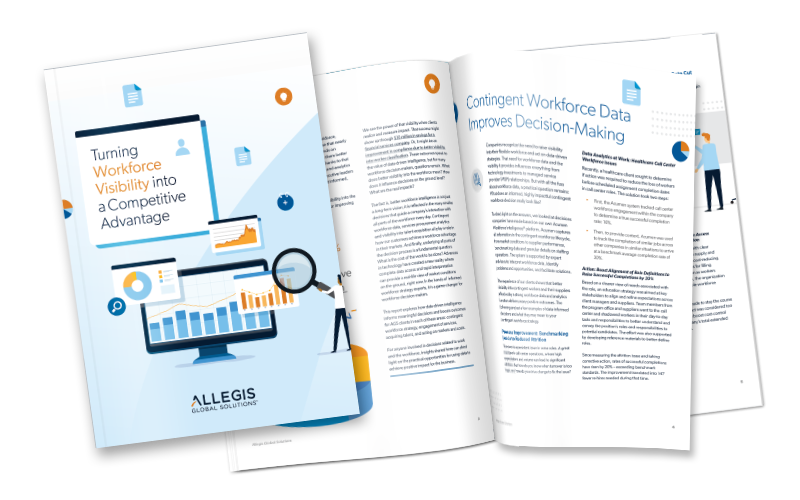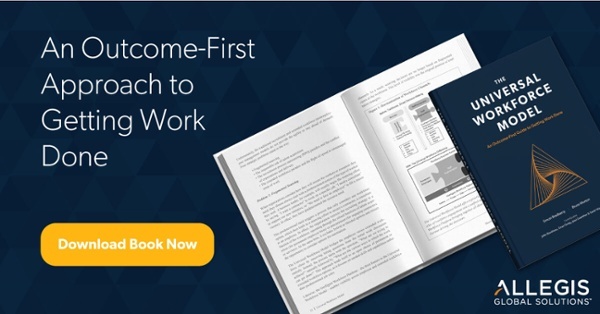A Task- Versus Role-Based Approach to Deconstructing Work
Note: This blog is excerpted from chapter four in AGS’ The Universal Workforce Model: An Outcome-First Guide to Getting Work Done
The Universal Work ModelTM considers that work can be done by regular employees, but it also embraces the increasingly diverse array of alternative workers and resources. Engaging such workers requires work arrangements that look beyond typical definitions of jobs and the assumption that the worker will be a full-time employee who holds a series of jobs in the organization.
Along with co-authors in several past books (“Beyond HR,” “Lead the Work” and “Reinventing Jobs”), I have argued that solving the future of work requires “deconstructing” jobs and then the capabilities of the jobholders. In essence, reexamine the job by its component tasks and the workers as owners of capabilities to achieve those tasks.
The task-first approach is naturally empowering for the worker, as it breaks down the limiting bundling of activities that traditionally comprise what we refer to as jobs.
Often, only a portion of those bundled tasks directly uses the worker’s best skill or strengths. Also, if workers are freed to take on projects beyond their formal job, the organization can tap additional worker capabilities. With a task-driven approach to work, the activities are separated from the pack-aging known as the “job.” This reveals many more options than the traditional concept of work as a “job” and the worker as a “jobholder.”
Benefits of a Task-Based Approach to Workforce Strategy
The move to empower companies and workers through a new approach is recognized as a priority today. As a June 2020 Harvard Business Review article reinforces, “all knowledge-based work can be unpacked into a set of different tasks. … To figure out the future of the gig economy for knowledge workers, therefore, we need to analyze things at the task rather than at the work level.”
Workers can now be seen not simply as jobholders but as repositories of a complete array of existing and potential capabilities. One example is a skills-based work system. COVID- 19 revealed this when workers making auto parts or vodka can be provided with just the right few additional skills and become makers of personal protective equipment and hand sanitizer. The new “jobs” did not exist previously.
One way to see the growing imperative for work deconstruction is in the increasing array of alternative work arrangements, often called a “talent ecosystem.” The list below is adapted from the Institute for Corporate Productivity and illustrates the most common work arrangements within such an ecosystem.
- Talent exchanges: Build capability, perspective and relationships by swapping/rotating talent with entities outside your enterprise.
- Gig workers or freelancers: Access on-demand skills and capabilities when/where needed using external talent platforms.
- Crowdsourcing: Obtain input, information and ideas from a curated audience internally and externally to the organization.
- Innovation partnerships: Engage start-up organizations and/or academic units for new ideas, commercialization or launching new ventures.
- Co-ops/internships/apprenticeships: Use students and others who are early in their careers or are making a career transition to take on specific tasks and build a future talent pipeline.
- Nontraditional talent: Source talent from traditionally under-tapped sources, such as underserved populations, socioeconomic groups and differently abled people.
- Internal talent marketplace: Offer employees flexible opportunities to take on projects or tasks beyond their jobs to fill unmet needs.
Regular, full-time employment in traditional jobs should be on this list, but it should not be the only option. Instead, it should be one of several options that are optimized to best engage human workers. However, for most organizations, the list includes only employees in jobs.
Deconstructing Full-Time Employment
In the book “Lead the Work,” my colleagues Ravin Jesuthasan and David Creelman and I proposed three work engagement dimensions that can help leaders consider how to redesign work to better tap alternatives to regular full-time employment:
- The assignment (or the work to be done)
- How small can it be deconstructed?
- How widely can it be dispersed?
- How far from employment can it be detached?
- The organization (the boundary containing the work)
- How easily can the organization boundary be permeated?
- How strongly should the organization link with others?
- How deeply should the task involve collaboration?
- How extensively should the boundary be flexed to include others?
- The rewards (the elements of exchange for the work)
- How small or immediate is the time frame?
- How specifically should rewards be individualized?
- How creatively should rewards be imagined beyond traditional pay and benefits?
For example, organizations contain the job of product designer, which includes many tasks. One of those tasks is generating ideas for new products or features, combined with other tasks, such as evaluating those ideas to fit with existing production or marketing strategies and selling the ideas to key organization constituents.
If we deconstruct the job, then the task of generating new product ideas emerges as one “assignment” that can be deconstructed from the rest of the job. That task can be undertaken by volunteer focus groups, perhaps comprised of regular customers, dispersed to a wide array of volunteers and detached from an employment contract. The “organization” boundary must be permeated but only enough to allow the volunteers to interact with product design teams.
Notice, however, that if the question is framed as, “Can volunteer focus groups do the job of product designers?” then the answer is simply “no,” and this alternative does not present itself. Similarly, if the question is framed as, “How can we design a job that consists only of suggesting new products and features?” then the answer is, “impossible” because the organization does not have enough of such work to fill a regular job. The COVID-19 crisis accelerated this melting or “deconstruction” of work and workers, requiring a concept of work that moves beyond the traditional job. Workers, managers and leaders will want to keep the agility that comes with deconstruction and reinvention, but they will need new systems that go beyond traditional jobs.
Move Beyond the Traditional Job with a New Approach
The Universal Workforce Model frames these questions in terms of deconstructed tasks. Rather than asking, “Can we substitute alternative work arrangements for the employees in our current jobs?” consider asking if the work can be arranged by tasks to better suit the capabilities of current workers. Framing these questions through task-based work provides a far clearer picture of the opportunities and challenges of alternative work arrangements. Task-based work offers the same clarification regarding equally significant imperatives, such as work automation and skills-based work systems.
Work deconstruction is essential. Organizational leaders, managers, workers and policymakers must evolve toward liberating work from jobs, liberating worker capabilities from job requirements and liberating worker qualifications from college degrees. Only then will we see the true patterns and optimal solutions promised by a Universal Workforce Model.






.png?width=160&name=MicrosoftTeams-image%20(12).png)